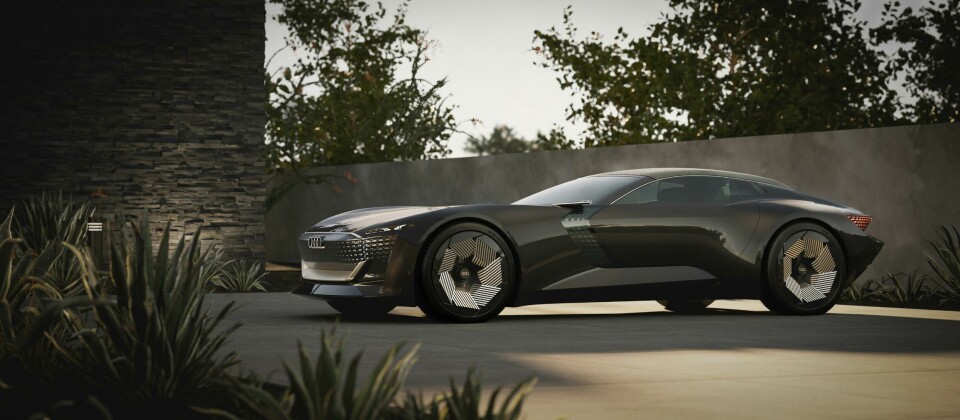
Audi’s Skysphere concept grows from sporty roadster to autonomous grand tourer
A futuristic show car with classical proportions, the Skysphere concept is a reflection of Audi’s commitment to electric and autonomous mobility
Audi has unveiled the first of three new concept cars that showcase its future design direction, underscore its commitment to go all-electric by next decade, and highlight its plans to make autonomous production cars in the next three years. The Skysphere is two cars in one: a level 4 autonomous grand tourer and a sporty, driver-focused roadster that becomes 250 millimeters shorter with the touch of a button.
The Skysphere concept was created completely digitally at Audi’s new design studio in Malibu, California. Unlike the former full-service studio in Santa Monica that shuttered in 2016, the new space is equipped only with computers, VR equipment, and a visualisation room. Last year Gael Buzyn, head of the Malibu studio, was asked by his boss Marc Lichte to develop a show car that had level 4 autonomy at the center. Other than that, there were no rules. “The design brief was basically a blank check,” Buzyn tells us. “We were free to express our vision of what level 4 could be in the future.”
For this car, Buzyn and his team wanted to explore the idea of modern grand touring. “In the past, a grand tourer usually offered a compromised experience,” he says. “But the Skysphere uses a reconfigurable interior to offer two distinct personalities – spacious and comfortable in the GT mode and driver-focused in the sport mode.” The car is elegant and streamlined, with big wheels, a long dash-to-axle, the silhouette of a speedster, and the practicality of a shooting brake.
At a time when many designers are using electric powertrains as an opportunity to redefine proportions, Buzyn and his team wanted to take a more classical approach. “I have this dystopian vision of the world with everyone riding around in their little rolling port-a-potties, and that’s why I did this car. People ask me why we did this proportion on an EV, and I think it makes sense on a certain type of vehicle. I don’t believe beauty changes overnight.” Buzyn and his team were inspired by the Horch 850 roadster and other cars of the 1930s that took advantage of technological advances to make motoring more comfortable. Homages to the Horch can be seen in the rearward-opening doors, the wheel design, and some of the art-deco-style chrome elements in the cabin.
Buzyn says the biggest challenge was to make the Skysphere look good with two different lengths. “We tried many configurations, for where the windshield would be, how long the bonnet is, the size of the cabin – but one was always off.” Finally, they came up with a solution: A decorative element on the body side beneath the A-pillar (which reminds us in some ways of the “side blade” on the Audi R8) that stretches or shrinks with the car. “This element really helped us a lot with the transition,” he says.
Audi have some of the best lighting design in the business thanks to the team in Ingolstadt led by César Muntada, and the Skysphere is no exception. A large lighting signature where the front grille would be replaces the traditional Audi singleframe grille but keeps a family resemblance (thanks in part to a very prominent four-ring emblem), flanked by intricate, 3D-printed DRLs. As we’ve seen with other electric and autonomous designs, the front lighting pattern changes colour to communicate the current driving mode and charging status. Front and rear lights are programmed with animation that gives the car a futuristic quality without being obnoxious.
In the cabin, the seats sit side-by-side in GT mode, with large display screens across the IP that can show artwork or other entertainment while passengers relax. When transformed into Sport mode, a steering wheel emerges from under the dash, the driver’s screen moves forward for better visibility and the driver’s seat comes slightly forward in a staggered configuration. Buzyn tells us the crystal elements on the paddle shifters, gear shifter, and analogue clock were inspired by objets d’art such as Lalique perfume bottles. All materials are sustainable, including the eucalyptus wood trim and the seat fabric, which the team named “agave” after the bluish colour of the succulent found in Southern California.
Creating the Skysphere took the team only about six months, including two months to fabricate the car in Germany. “I didn’t think in my lifetime I’d ever see a concept car being built so quickly,” Buzyn says. “What’s incredible is to see the young designers move so naturally through this digital world. The hardest was for us old dogs trying to evaluate the design through the goggles. This experience made us better, too.”
The Audi Skysphere concept will be shown to the public this week at the Pebble Beach Concours d’Elegance in California. The second of brand’s three autonomous concepts, the Audi Grandsphere, is a closer-to-production touring car slated to debut next month at the IAA in Munich.




























